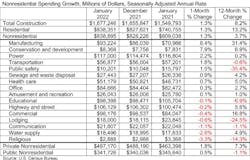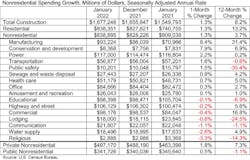Inflation a Deeper Dent to Low Nonresidential Construction Spending
WASHINGTON, March 1 — National nonresidential construction spending was up 1.3% in January, according to an Associated Builders and Contractors analysis of data published today by the U.S. Census Bureau. On a seasonally adjusted annualized basis, nonresidential spending totaled $838.9 billion for the month.
Spending was up on a monthly basis in nine of the 16 nonresidential subcategories. Private nonresidential spending increased by 1.8%, while public nonresidential construction spending rose 0.5% in January.
“Normally, one would look at headline numbers indicating that construction investment rose in America as a reason to cheer,” said ABC Chief Economist Anirban Basu. “But the construction spending data are not adjusted for inflation, and in real terms, construction spending was likely down for the month. Total construction spending is up more than 8% from last year, but materials prices are up approximately 24% over that span. Worker compensation costs have also been rising rapidly. As a result,“Circumstances are worse in the nonresidential construction segment,” said Basu. “While construction spending is up 13% in the industry’s residential component, nonresidential spending is up less than 4% year-over-year. In certain categories, spending is down in both real and nominal terms. The fading of pandemic-related construction spending has produced a decline of 35% in the public safety segment. Financial impacts on the education sector stemming from the pandemic have resulted in a 7% decline in education-related construction spending. Spending in the beleaguered lodging segment is down nearly 25% in nominal terms.
“The Russian invasion of Ukraine will not help,” said Basu. “Oil and other key input prices are rising, placing further upward pressure on the cost of delivering construction services. Those elevated costs have already been leading some project owners to postpone projects in the hope of procuring more favorable bids in the future. Steel, copper, aluminum, neon and nickel prices are all implicated by the outbreak of war, and sanctions on Russia and limits on its exports will be in place long after hostilities end.”

